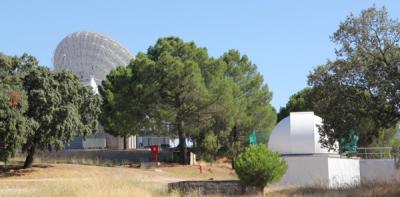CESAR (Cooperación a traves de la Educación sobre Ciencia e Investigación Astronómica) es un programa educativo desarrollado por el INTA, ISDEFE y la ESA, para promover la ciencia astronómica entre los más jóvenes.
En este sentido, el equipo CESAR está contruyendo una red de observatorios (ópticos nocturnos, telescopio solar y una antena de observación en radiofrecuencia)
La última adquisicion para el equipo ha sido este telescopio tipo Cassegrain de 50cm, que estará situado en la estación de espacio profundo de la ESA en Cebreros (Ávila)
El telescopio opererá automáticamente, sin necesidad de control en tiempo real, y estará dedicado a la observación de objetos cercanos a la Tierra (NEOs) detección fotometrica de exoplanetas y descubrimiento de supernovas, entre otros.

El domo del nuevo observatorio, con la antena de espacio profundo de la ESA detrás